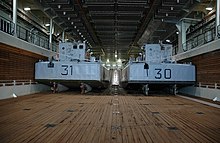Welldeck

Well deck , more rarely also well deck , low deck or lowered deck (from English well for well ), is the deepest area between the higher decks in front of and behind on ships with decks of different heights. The name is derived from the fact that water overflows from the higher areas like in a well shaft here, so that this deck is particularly often under water. In so-called corrugated deck ships , the corrugated deck is the uncovered area of the main deck between the forecastle and maneuver deck, i.e. between the raised bow area and the roughly central superstructure.
In modern dock landing ships , the multi-storey cargo space in the stern of amphibious assault ships , which can be flooded if necessary and can be entered by landing boats in the aft through a large gate , is often referred to as a well deck. In Anglo-American usage, however, well dock is also used for this .
How well decks work on military ships
During the crossing the gate is closed and the well deck is dry. When the ship reaches its operational area, large ballast tanks at the side are filled with water until the stern of the ship sinks so far into the sea that the well deck is flooded. The additional immersion depth is up to 10 meters. The ship stands still or makes slow travel.
Vehicles, trucks and tanks drive from the transport decks inside the amphibious assault ships over a ramp into the landing craft. The fully loaded landing craft leaves the hull of the ship via the now lowered gate and steers towards the coast to unload its cargo there. The ships are located 50–100 kilometers from the coast in international waters and are largely protected from enemy fire. This mode of operation is also called Over the Horizon (OTH, dt. Behind the horizon).
Flooding of the well deck is not necessary for operations with LCAC air-cushion boats . These can slide directly onto the surface of the sea via the open gate as a ramp. The Amtrac -Schwimmpanzer the Marine Corps do not need a landing craft, but depart from Welldeck directly into the open sea.
Well decks on dock landing ships can be more than 100 m long, so that a large opening at the top amidships was built in some of them for faster loading using a loading crane .
All corresponding ships of the US Navy have to qualify for these amphibious operations every year, the so-called Well Deck Certification .
Dimensions
Dimensions of the well decks of known ship classes:
| class | marine | Type | Length in m | Width in m | Area m² |
| Tarawa class |
|
LHA | |||
| Wasp class |
|
LHD | 81.4 | 15.2 | 1237 |
| Whidbey Island class |
|
LSD | 134.1 | 15.2 | 2038 |
| Foudre class |
|
LSD | 122.0 | 14.3 | 1745 |
| Ouragan class |
|
LSD | 120.0 | 13.2 | 1584 |
| Mistral class |
|
LHD | 885 | ||
| San Antonio class |
|
LPD | 55.0 | 14.0 | 770 |
| Albion class |
|
LPD | 60.0 | 15.0 | 900 |
| Bay class |
|
LSD | 39.0 | 14.0 | 546 |
| Canberra class |
|
LHD | 69.3 | 16.8 | 1164 |
Other dock landing ships are operated by the Italian , Dutch , Spanish and Chinese navies.


